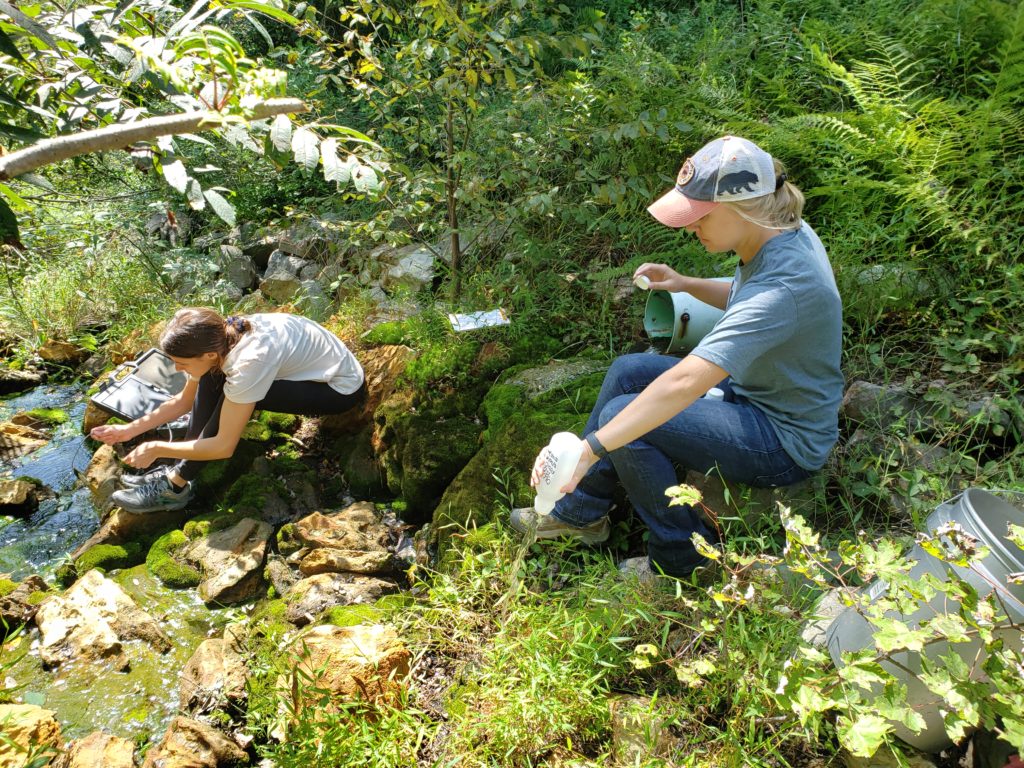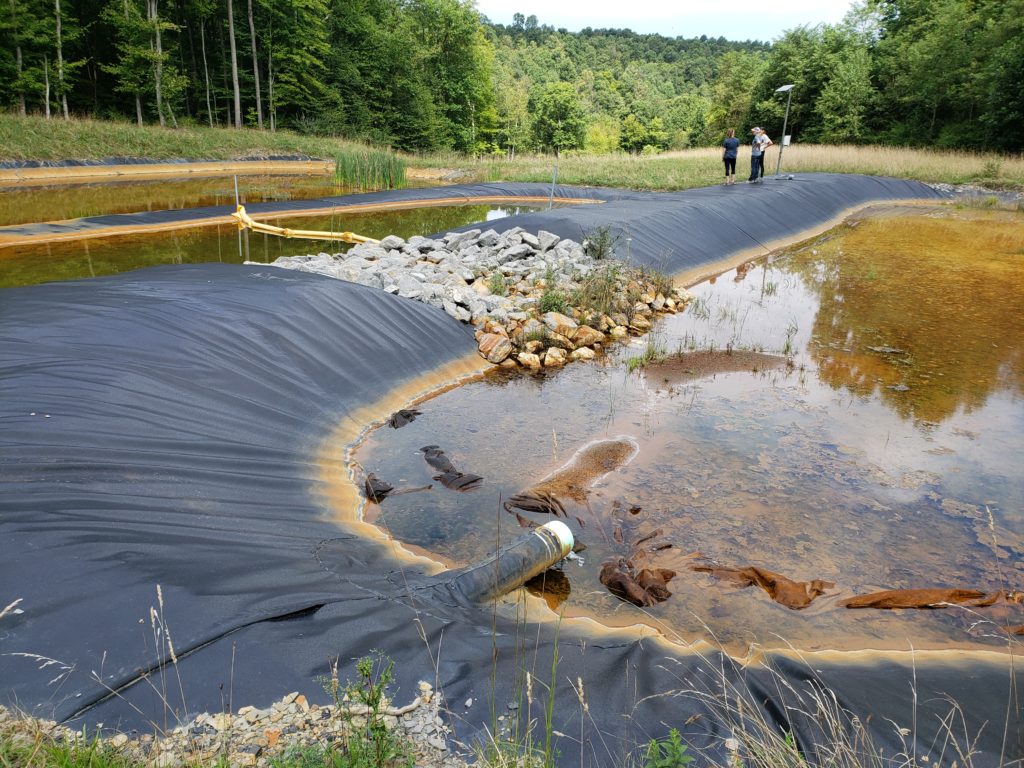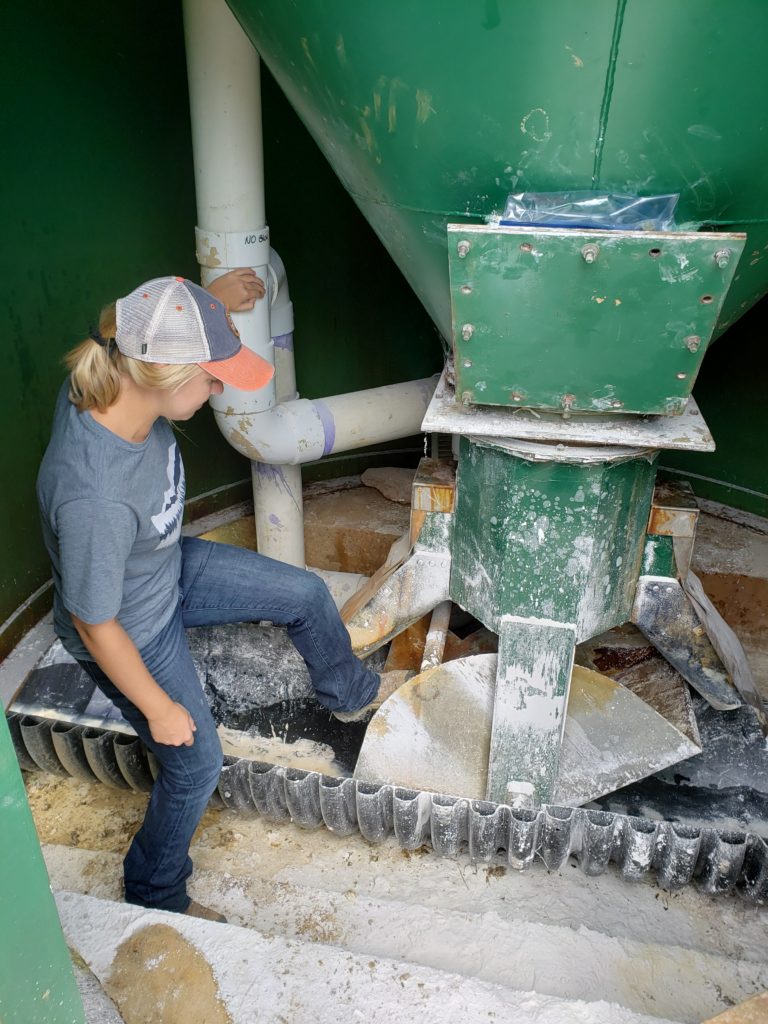MORGANTOWN — The Dominion Post spent part of a warm Labor Day weekend Friday with Friends of Deckers Creek, learning how they sample water and visiting a couple acid mine drainage treatment sites.

With FODC Executive Director Sarah Cayton and AmeriCorps VISTA staffers Maddie Ferrell and Rachel Pell, we made our first stop at the scenic waterfalls in the gorge below the Lions Club picnic shelters off W.Va. 7. There, they demonstrated how they do their quarterly sampling at the 13 sites along the creek for their Clean Creek Program (the next testing is set for some time in September).

Ferrell began by dangling a probe into a rushing channel below the falls, measuring for pH, temperature, conductivity and total dissolved solids.
“What we try and do is get in the middle of the stream,” Ferrell said. “If you’re up on the bank it’s not going to be as accurate because the water’s kind of stagnant.”

She called out the readings to Cayton, who stood nearby and jotted them onto a note sheet. The pH was 8.6, slightly base and a fairly good reading; temperature was 17.7C (63.86F). Conductivity was 772 and TDS, measured in parts per million, was 386.
The conductivity – a measure of metals in the water – and ppm were unusually high, Ferrell said, because of the low summer water flow and inadequate dilution. “Typically this is our best site.”

A ppm of 300 is average for West Virginia, Cayton said, while water right out of mine portal pipes measures in the thousands. “Once the rain comes it’ll dilute it.”
Pell climbed down a level below and Rachel and demonstrated how they collect three samples bottles of water to be tested at WVU. One is just plain water that would be tested for pH and conductivity. Another is water that will have a preservative added, and would be tested for total metals. The third is filtered and preserved, and would be tested for dissolved metals.

From there, the teamed up to sample the stream depth and flow. Pell and Ferrell stood on either bank, a yellow tape measure stretched between them. Cayton held a calibrated metal pole with a probe at the bottom, attached to meter that looks a bit like an oversize, old-fashioned mobile phone.
At set intervals across the stream, she plunged the pole in and called out the readings to Pell, who was recording the data. They take three readings per site, Cayton said, and average out the three at each of the testing sites. “This is by far the longest part of the process.”

From the gorge they heading up into Preston County, to quit wooded spot on a hillside west of Bretz where a green PVC drain pipe channels raw mine water down a limestone channel to a tributary of Slabcamp Run, which runs into Deckers Creek.
The site, for now, is called OLC 750, for open limestone channel. Pending grants and agreements with the landowners, it will be a new AMD remediation site, probably three years and about $200,000 down the road.
Cayton explained how they go about choosing AMD remediation sites. FODC has a watershed base plan – essentially a prioritized list of streams and tributaries in the Deckers Creek watershed. It was last updated in 2015 and the aim is to treat sites in priority order, or as close to it as possible given all the various conditions it takes to establish a site.
They are in the midst of landowner talks on this one, she said. They have a state Department of Environmental Protection grant and just need construction funds via a U.ZS. Office of Surface Mining Watershed Cooperative Agreement Program grant.
The WCAP grant, Cayton said, requires 12 months’ worth of new testing data, and this was the day they chose for another monthly test.
The raw mine water was turning the channel rocks red. There was an unusual amount of moss and algae growing but they didn’t know why. They began by measuring the flow from the pipe. Ferrell held a tall plastic cylinder under the flow while Cayton timed how long it took to fill it.
Then they collected samples into bottles.
Just below, Pell perched at the edge of the stream, inserting the probe into the water to test for pH and conductivity. Here, the pH was 3.03, highly acidic, and the conductivity was 1,547 – about double the gorge site.
Cayton pointed out that the landowners don’t collect any rent for treatment sites on their properties. “People who donate their land to have this done on are the people that deserve all the praise. What a selfless thing, I think, to give up your land.”
AMD remediation sites
FODC has seven AMD treatment sites along tributaries of the creek – six on Kanes Creek, one on Slabcamp.
We visited two sites along Kanes Creek – one passive, one active.
The passive site, completed in 2016, sits east of Reedsville and south of W.Va. 7, and treats water from the abandoned Ingrand Mine. It consists of an iron oxidation terrace and four ponds.
Water flows through a pipe out of the mine to the oxidation terrace, where it’s introduced to limestone, Cayton said. This adds oxygen to the AMD and lets metals precipitate out. From there it flows through a long pipe down to the first pond, and they’re having a bit of a problem with that at the moment.
The precipitated metals are clogging the pipe, she said. “We’re going to try to rework that a little bit. … This site works really well to lower the metals; it’s definitely from a maintenance standpoint something we want to fix.”
The first pond is a limestone settling pond, drained into the next settling pond by a solar-powered flusher every 24 hours. That settling pond drains into a vertical flow wetland pond, where the plants help oxygenate and filter the water. From that pond, the water flows a few hundred yards down an open limestone channel to the final settlement pond, an aerobic wetland.
The active site, Valley Highwall 3, sits immediately adjacent to W.Va. 7, between Kanes Creek United Methodist Church and the auto dealership and turnoff to Hovatter’s Zoo.
This site was completed in 2010 but has been offline for a time for some upgrades. The last item is installing a liner in the first pond, to prevent water leakage through the pond wall. “Barring any major issues, within the next two weeks this should be online,” Cayton said.
The engineer calls this site a pretzel, Cayton said, because the water flows in twisted loop, unlike Ingrand.
The raw mine water first enters a siphon pool – the one that needs a liner – which fills until the water hits the siphon vault and flushes out.
It then flows through a trompe, a pipe that flows up and down like a sea serpent’s back. This creates air pressure that powers a mixing well down the line. From the trompe, the water flows into the tall lime doser silo, where it runs past a tipping bucket that rocks back and forth and portions set amounts of powdered limestone into the water.
The water is piped out of the doser into the mixing well, to more thoroughly mix the lime and water. From there it passes through two settling ponds and down a pipe into Kanes Creek.
This site has one more feature. Because it generates a lot of iron, sludge is pumped up the hill to a deep sludge pond. An underground drain lets clean water drain down into the water table. If it gets too full and isn’t draining, water can be pumped back down to run through the system again.
Because the pond is so big, Cayton says, no one knows how many years from now it might fill with sludge, or what they’ll do with it if it does reach that point.
Tweet David Beard @dbeardtdp Email dbeard@dominionpost.com




